CIVIL TECHNOLOGY GRADE 12 MEMORANDUM - NSC PAST PAPERS AND MEMOS FEBRUARY/MARCH 2018
Share via Whatsapp Join our WhatsApp Group Join our Telegram GroupCIVIL TECHNOLOGY
GRADE 12
NSC PAST PAPERS AND MEMOS
FEBRUARY/MARCH 2018
MEMORANDUM
QUESTION 1: CONSTRUCTION, SAFETY AND MATERIAL
1.1
1.1.1 B ✔ (1)
1.1.2 E ✔ (1)
1.1.3 A ✔ (1)
1.1.4 D ✔ (1)
1.1.5 F ✔ (1)
1.1.6 C ✔ (1)
1.1.7 H ✔ (1)
1.1.8 I ✔ (1)
1.1.9 G ✔ (1)
1.1.10 J ✔ (1)
1.2
1.2.1 A – To protect your feet against falling objects. ✔ (1)
1.2.2 B – To protect your feet when working with wet material. ✔ (1)
1.3 The paint conceals defects ✔ (1)
1.4
- Excavations must be fenced off. ✔
- Red warning lights should be placed at intervals to warn the public. ✔
- All excavations must take place under supervision.
- The contractor must test the stability of the terrain before commencement of excavations.
- Shoring should be cross braced.
- Bracing should be strong enough to support the shoring.
- No tools or materials other than those in use are allowed inside the trench when excavations are in progress.
- Access to the excavation should be safe e.g. ladders can be used.
- A responsible person must inspect and investigate underground electricity and water supply.
- The sides should be braced and protected if deeper than 1,5 meters.
ANY TWO OF THE ABOVE OR ANY OTHER ACCEPTABLE ANSWER (2)
1.5
- Baseplate ✔
- Mould/Cube ✔
- Tamping rod ✔
- Plaster trowel/straight edge/shovel
ANY THREE OF THE ABOVE (3)
1.6
- Water makes the fresh concrete workable. ✔
- Water acts as a lubricant.
- Water is also needed for the hydration process.
ANY ONE OF THE ABOVE (1)
1.7
1.7.1To prevent moisture from getting into the building. ✔ (1)
1.7.1 To prevent moisture from moving up in the walls. ✔ (1)
1.8
- Preservatives with a base of water-soluble salts. ✔
- Varnish
ANY ONE OF THE ABOVE (1)
1.9 Roof tiles/Clay tiles/Concrete tiles ✔ (1)
1.10 Ridge capping ✔ (1)
1.11 Gang nails/plate connectors ✔ (1)
1.12 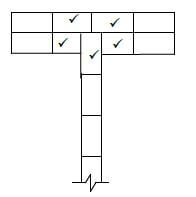 (5)
(5)
ASSESSMENT CRITERIA | MARK | CANDIDATES MARK |
One brick wall | 2 | |
Half brick wall (T-junction) | 1 | |
Three-quarter bricks | 2 | |
TOTAL | 5 |
[30]
QUESTION 2: ADVANCED CONSTRUCTION AND EQUIPMENT
ANSWER THIS QUESTION ON A NEW PAGE.
2.1
2.1.1 C ✔ (1)
2.1.2 D ✔ (1)
2.1.3 A ✔ (1)
2.1.4 B ✔ (1)
2.1.5 A ✔ (1)
2.2
2.2.1 Portable electric generator ✔ – It is used to generate electricity ✔ (2)
2.2.2 Portable electric circular saw ✔ – It is used for cross cutting and ripping of timber. ✔ (2)
2.3 Chalk line ✔ (1)
2.4
- Flat steel square ✔
- Tape measure
ANY ONE OF THE ABOVE (1)
2.5
- Rough arch will be built with common bricks ✔
- Gauge arch will be built with face bricks ✔ (2)
2.6
2.6.1 Driven in-situ pile ✔ (1)
2.6.2
- Low bearing capacity of soil ✔
- Subsoil – subjected to movement ✔
- Subsoil – subjected to high moisture content.
- Recently placed filling materials that is not sufficiently compacted
- Unstable soil structure
- High water table
ANY TWO OF THE ABOVE (2)
2.6.3 Steel reinforcement ✔ (1)
2.7
2.7.1 Twisted square bar ✔ (1)
2.7.2 Round bar (mild steel) ✔ (1)
2.8
- – Landing ✔
- – Rise ✔
- – Tread ✔ (3)
2.9
- Blow holes ✔
- Uneven colour/discoloration ✔
- Honey comb effect/Leaking of grout
ANY TWO OF THE ABOVE (2)
2.10
2.10.1 Cavity wall ✔ (1)
2.10.2
- A – Wall tie ✔
- Keeps the two skins of the wall securely together. ✔
- It strengthens the wall
ANY TWO OF THE ABOVE (2)
2.10.3
- B – Weak concrete mixture ✔
- Concrete mixture
ANY ONE OF THE ABOVE (1)
2.10.4
- To strengthen the wall below the DPC (damp proof course) ✔
- To close the cavity below the damp proof course
ANY ONE OF THE ABOVE (1)
2.10.5 C – Damp-proof membrane ✔ (1)
2.10.6 50 mm ✔ (Unit must be part of the answer) (1)
2.11
2.11.1
- – Cladding (or any cladding material) ✔
- –
- Timber floor board ✔
- Base plate
- Base board
ANY ONE OF THE ABOVE FOR B (2)
2.11.2
- Steel ✔
- Metal
- Aluminium
ANY ONE OF THE ABOVE (1)
2.11.3
- There is no wet material ✔
- There is no heavy material to carry ✔
- Dry walls are light in weight.
- Dry walls are easier to install
- Dry walls are easy to remove if required
ANY TWO OF THE ABOVE (2)
2.12
2.12.1 Rib and Block floor ✔ (1)
2.12.2
- – Rib ✔
- – Hollow block/Block ✔
- – Reinforcing steel/Steel rod/Reinforcement ✔ (3) [40]
QUESTION 3: CIVIL SERVICES
3.1
3.1.1 P-trap ✔ (1)
3.1.2 Washbasin/Urinal/Shower/Sink ✔ (1) ANY ONE
3.2
3.2.1
- -Is the inlet pipe for cold water ✔
- -Is the outlet pipe for warm water ✔ (2)
3.2.2 To shut down water supply during maintenance. ✔
ANY OTHER ACCEPTABLE ANSWER (1)
3.2.3
- To prevent water from leaking through the ceiling ✔
- It is compulsory to install a drip tray
ANY ONE OF THE ABOVE (1)
3.3
3.3.1 Storm water is hail, snow, rain that falls to the earth in large quantities. ✔
ANY OTHER ACCEPTABLE ANSWER (1)
3.3.2 Storm water is guided into the channels where after the water is guided to storm water pipes and catchment areas. ✔
ANY OTHER ACCEPTABLE ANSWER (1)
3.4 Water in shallow wells is:
- Easily dug out ✔
- Cheap
- Relatively reliable
ANY ONE OF THE ABOVE (1)
3.5 Wind pump ✔ (1)
3.6 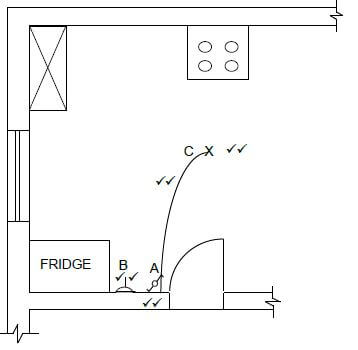 (8)
(8)
ASSESSMENT CRITERIA | MARK | CANDIDATE'S MARK |
2 way light switch | 2 | |
Socket outlet | 2 | |
Light | 2 | |
Electrical wire | 2 | |
TOTAL | 8 |
3.7 ANSWER SHEET 3.7 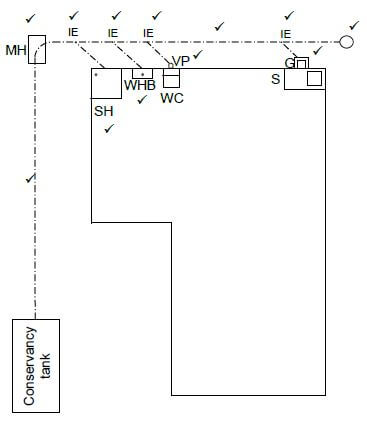 (12)
(12)
ASSESSMENT CRITERIA | MARK | CANDIDATE'S MARK |
Rodding eye | 1 | |
Gully | 1 | |
Vent pipe | 1 | |
Main sewerage pipes | 2 | |
Inspection eyes | 4 | |
Manhole | 1 | |
Any TWO abbreviations for the sanitary fixtures | 2 | |
TOTAL | 12 |
[30]
QUESTION 4: QUANTITIES, MATERIALS AND JOINING
4.1
4.1.1
- Gang nail ✔ (1)
USE: - Gang nails are used to join the members of roof trusses. ✔
- Extend the length of a timber board/beam.
ANY ONE OF THE ABOVE USES (1)
4.1.2
- Bolt and nut ✔ (1)
USE: - Bolts and nuts are used to join the members of roof trusses. ✔
- Join material to brackets
- To fix truss hangers to rafters
ANY ONE OF THE ABOVE USES (1)
4.1.3
- Dry wall screw ✔ (1)
USE: - Drywall screws are used to fix dry wall materials. ✔
- Joining ceilings and battens to other members
- Joining timber to each other (1)
ANY ONE OF THE ABOVE USES
4.2
- Rawl bolt/Expansion anchor ✔
- Sleeve anchor
- Dina bolt
ANY ONE OF THE ABOVE (1)
4.3
- Compression joint ✔
- Capillary joint
ANY ONE OF THE ABOVE (1)
4.4
- Screws have greater holding power than nails ✔
- They can be fixed where vibration has to be avoided ✔
- Screws can easily be removed
- The appearance of screws is better in finishing than nails
ANY TWO OF THE ABOVE (2)
4.5
4.5.1 38 or 38 mm ✔ (1)
4.5.2 2 349 or 2 349 mm ✔ (1)
4.5.3 5 √ (1)
4.5.4 2 575 or 2 575 mm ✔ (1)
4.5.5 5 150 or 5 150 mm ✔ (1)
4.5.6 4 500 or 4 500 mm ✔ (1)
4.5.7 10 300 or 10 300 mm ✔ (1)
4.6
A | B | C | D |
Inside measurement of: | |||
Long walls = 6 500 – 2/220 ✔ | |||
= 6 060 mm ✔ | |||
Short walls = 3 800 – 2/220 ✔ | |||
= 3 360 mm ✔ | |||
(4) | |||
1/ | 6,06 | Inside floor area of the room is | |
3,36 ✔ | 20,36 m2 ✔ | (2) | |
Area of one ceiling board: | |||
1/ | 3,9 | One board is 3 900 mm x 900 mm | |
0,9 ✔ | 3,51 m2 ✔ | (3) | |
Length of skirting: | |||
= 2(6 060 ✔+ 3 360 ✔) – 900 mm ✔ | |||
= 17,94 m ✔ | |||
OR 12 120 + 6 720 - 900 | |||
=17,94 m | |||
OR 6 060 + 6 060 + 3 360 + 3 360 - 900 | |||
=17,94 m | |||
(4) | |||
(13) |
[30]
QUESTION 5: APPLIED MECHANICS
5.1
5.1.1
- (A1 x d) + (A2 x d)
Total area
= (3 200 x 20) + (900 x 60)
4 100 ✔
= 64 000 mm3 + 54 000 mm3
4 100
= 118 000 mm3 ✔
4 100 mm2
= 28,78 ✔ mm ✔
OR
Part | Area (A) | Y | AY |
1 | 3 200 mm² ✔ | 20 mm ✔ | 3 200 x 20 = 64 000 mm3 ✔ |
2 | 900 ✔ mm² | 60 mm ✔ | 900 mm x 60 mm = 54 000 mm3 ✔ |
∑ | 4 100 mm² ✔ | 118 000 mm3 |
- Y = ∑ Ay
∑ A
= 118 000 mm3 ✔
4 100 mm2
= 28,78 ✔ mm ✔ (10)
5.2.1
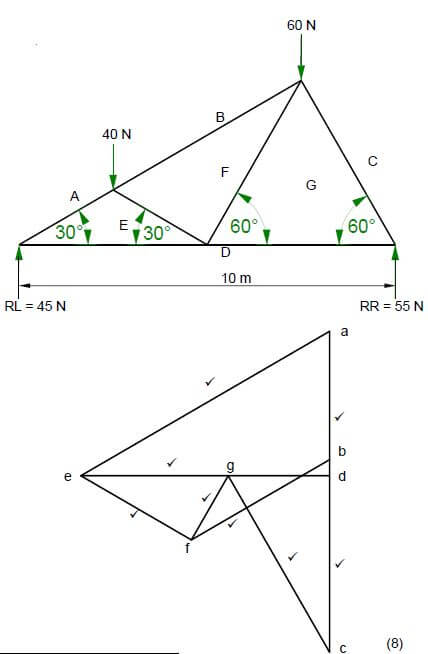 (8)
(8)
MEMBER | NATURE | MAGNITUDE |
FG | Tie ✔ | 23 N ✔ |
BF | Strut ✔ | 50 N ✔ |
Tolerance of 1 N to either side (4)
NOT TO SCALE DUE TO ELECTRONIC TRANSFER USE A MASK TO MARK THIS QUESTION
5.3
5.3.1 40 Nm ✔ (1)
5.3.2 7 m ✔ (1)
5.3.3 3 m ✔ (1)
5.3.4 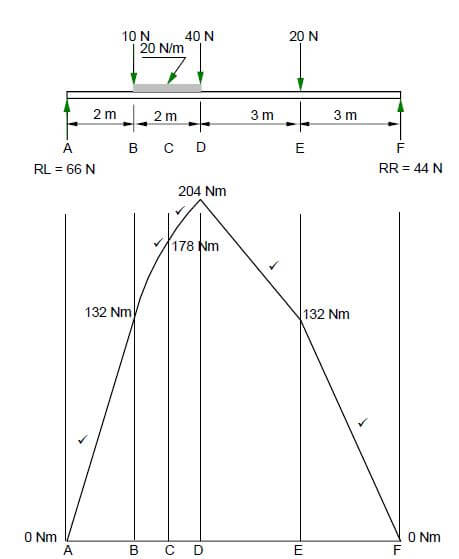 (5)
(5)
SCALE 1 mm = 2 Nm
NOT TO SCALE DUE TO ELECTRONIC TRANSFER
USE A MASK TO MARK THIS QUESTION
- If the bending moment diagram is not to scale, deduct 1 mark.
- Marks are allocated for each line between A to F.
- If the lines between B and D are straight lines no marks will be awarded for these lines. [30]
ANSWER SHEET 6.1
NO. | QUESTIONS | ANSWERS | MARKS |
1 | Name the scale used for the West elevation. | 1:100 ✔ | 1 |
2 | Identify number 1. | Barge board ✔ | 1 |
3 | Identify number 2. | Window/window pane/glass casement ✔ | 1 |
4 | Identify number 3. | Door/door opening ✔ | 1 |
5 | Identify number 4. | FFL/Finished floor level ✔ | 1 |
6 | Identify number 5. | Step ✔ | 1 |
7 | Identify number 6. | NGL/Natural ground level ✔ | 1 |
8 | Identify number 7. | Window sill ✔ | 1 |
9 | Name the material that can be used for the soffit board at a closed eave? | Fibre cement ✔ | 1 |
10 | Recommend a suitable exterior finish for the wall. | Paint/plaster/face brick/ cladding ✔ | 1 |
11 | Deduce on which elevations will the gutters be placed in this house? | North elevation ✔ and South elevation✔ | 2 |
12 | Draw the roof lines for the roof of the building shown in FIGURE 6.1 in the column alongside. |  | 3 |
TOTAL | 15 |
QUESTION 6: GRAPHICS AND COMMUNICATION
ANSWER SHEET 6.2 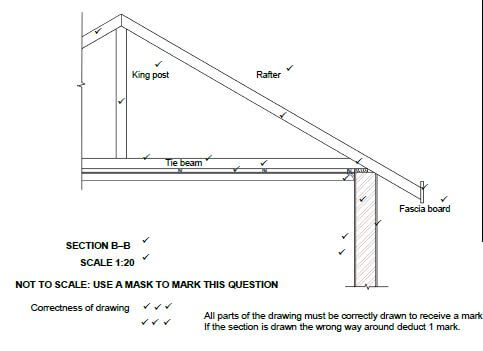
ASSESSMENT CRITERIA | MARKS | LM |
Correctness of drawing | 3 | |
External wall | 1 | |
Symbol for wall | 1 | |
Plaster | 2 | |
Wall plate | 1 | |
Tie beam | 1 | |
Rafters | 2 | |
King post | 1 | |
Brandering | 1 | |
Ceiling board | 1 | |
Cornice | 1 | |
Fascia board | 1 | |
Print title and scale | 2 | |
Any FOUR labels | 4 | |
Application of scale:
| 3 | |
TOTAL | 25 |
[40]
200